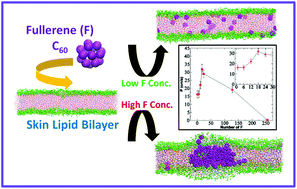Molecular dynamics simulation study of translocation of fullerene C60 through skin bilayer: effect of concentration on barrier properties†
Abstract
The molecular level permeation mechanism of fullerenes and its derivatives through human skin could open a vast area for designing novel nanoparticles for cosmetics and drug delivery applications. In this study, we report the permeation mechanism of pristine fullerene C60 for the first time through the skin lipid layer, as determined via prolonged unconstrained and constrained coarse-grained molecular dynamics simulations. The skin layer was modelled as an equimolar ratio of ceramides, cholesterol and free fatty acids. It was observed that at lower concentrations fullerenes formed small clusters (3 or 5 molecules) in the aqueous phase, which further spontaneously permeated inside the bilayer and remained dispersed inside the bilayer interior. On the other hand, at higher concentrations fullerenes aggregated in the aqueous layer, penetrated in that form and remained aggregated in the bilayer interior. Lower concentrations of fullerenes did not induce significant structural changes in the bilayer, whereas at higher concentrations undulations were observed. The permeability of fullerene molecules was found to be concentration-dependent and was explained in terms of their free energy of permeation (thermodynamics) and diffusivity (dynamics). On the basis of the aggregation and dispersion of fullerenes, an optimum fullerene concentration was determined, which could be used for drug delivery and cosmetic applications.



 Please wait while we load your content...
Please wait while we load your content...